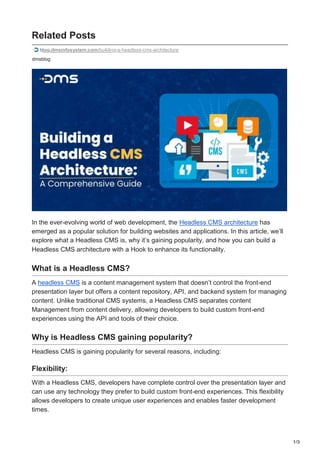Building a Headless CMS Architecture: A Comprehensive Guide
- 1. 1/3 Related Posts blog.dmsinfosystem.com/building-a-headless-cms-architecture dmsblog In the ever-evolving world of web development, the Headless CMS architecture has emerged as a popular solution for building websites and applications. In this article, we’ll explore what a Headless CMS is, why it’s gaining popularity, and how you can build a Headless CMS architecture with a Hook to enhance its functionality. What is a Headless CMS? A headless CMS is a content management system that doesn’t control the front-end presentation layer but offers a content repository, API, and backend system for managing content. Unlike traditional CMS systems, a Headless CMS separates content Management from content delivery, allowing developers to build custom front-end experiences using the API and tools of their choice. Why is Headless CMS gaining popularity? Headless CMS is gaining popularity for several reasons, including: Flexibility: With a Headless CMS, developers have complete control over the presentation layer and can use any technology they prefer to build custom front-end experiences. This flexibility allows developers to create unique user experiences and enables faster development times.
- 2. 2/3 Scalability: Headless CMS is highly scalable and can handle large amounts of content and traffic without affecting performance. The API-driven approach also allows developers to build applications that can be easily scaled horizontally. Security: Headless CMS architecture is more secure than traditional CMS systems as it doesn’t expose the back-end system to the internet, reducing the risk of attacks and data breaches. Cost-Effectiveness: Headless CMS systems can be more cost-effective than traditional CMS systems as they require fewer resources and can be hosted on scalable cloud platforms. How to Build a Headless CMS Architecture? Building a Headless CMS architecture can seem daunting, but it can be broken down into several key steps: Step 1: Choose the Right CMS Platform The first step in building a Headless CMS architecture is to choose the right CMS platform. There are several popular Headless CMS platforms available, including Strapi, Contentful, and Sanity. Every platform has different benefits and drawbacks, therefore it’s important to assess each choice in light of your particular needs. Step 2: Define Your Content Model Determining your content model comes after selecting your CMS platform. The types of content you’ll be managing, the attributes that make up each content type, and the connections between various content categories are all defined by a content model. Step 3: Create Your Content The next thing to do after establishing your content model is to start producing content. This can include text, images, videos, and any other media types you’ll be managing in your Headless CMS. Step 4: Set Up Your API The API is the backbone of a Headless CMS architecture and allows developers to access and manipulate content from the CMS. Setting up your API involves configuring your CMS platform to expose your content through a REST or GraphQL API. Step 5: Build Your Front-End Application
- 3. 3/3 The final step is to create your front-end application after your API is established. This involves using the API to fetch content from the CMS and displays it on your website or application. Your front-end application’s technology selection is up to you, allowing you to create a unique user experience that suits your unique demands. Using a Hook to Enhance Your Headless CMS Architecture While building a Headless CMS architecture is relatively straightforward, you can enhance its functionality using a Hook. A Hook is a piece of code that allows you to modify or extend the behaviour of a CMS platform. Hooks can be used to perform a variety of tasks, including: Integrating with third-party services: Hooks can be used to integrate your Headless CMS with third-party services, such as analytics. Modifying content: Before the content is transmitted to the front-end application or saved to the CMS, hooks can be used to change it. Extending functionality: Hooks can be used to extend the functionality of your Headless CMS by adding custom features or integrations. To use a Hook, you’ll need to identify the appropriate Hook point in your CMS platform and write custom code to execute. Hooks can be written in various programming languages, depending on your CMS platform. Conclusion Ultimately, creating a headless content management system design offers more flexibility, reliability, safety, and cost-effectiveness than conventional CMS systems. You need to choose the best CMS platform, establish your content model, produce your content, configure your API, and develop your front-end application before you can design a Headless CMS architecture. Using a Hook can also enhance the functionality of your Headless CMS architecture by allowing you to modify content, integrate with third-party services, and extend functionality. You can create a Headless CMS design that satisfies your particular requirements and offers a distinctive user experience by following these directions and using the power of Hooks.



